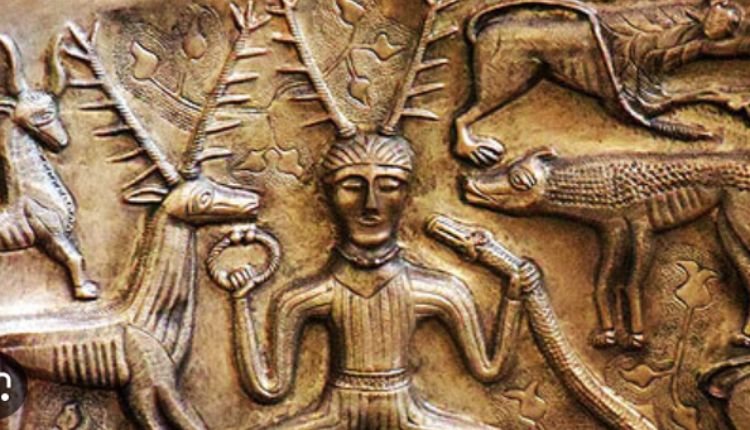
Celtic Religion
Although the Celts left no written religious texts, many aspects of their beliefs can be gleaned from archaeology and Greco-Roman accounts.
It is believed that the Celts had a strong belief in an afterlife. Burials of rulers and elite individuals would often include weapons, armour, tools, eating utensils, board games, extra food, and other items the deceased might need on their journey to or from the Otherworld, Tir na nOg.
Tuath De
The Tuatha De Danann (plural Tuatha Dé Danann) are the supernatural beings at the heart of the native mythological beliefs of Ireland, Scotland and the Isle of Man. These supernatural beings were the subjects of much of the poetry, drama and music that was produced in the pre-Christian Gaelic world.
The origins of the De Danann remain shrouded in mystery, although there are several theories. One theory is that they came from Denmark. Another is that they were a part of the ancient Irish race of people who were known as the Sidhe, or the Fairies.
These beings were said to have a very special relationship with the Earth and had control over a number of important natural events, such as crop ripening and cows’ milk production. They were also said to have the power to protect humans and animals from disease. In return for these gifts they asked to be worshipped.
This was done through a variety of rituals and ceremonies, including the festivals of Imbolc (February 1st), Beltaine (May 1st), Lughnasad (August 1st) and Samhain (October 31st). It is worth noting that these festival days had roots in the old megalithic traditions, so they may have been an important part of the ancient Celts’ lives.
There was a belief that the De Danann were immortal, although they could be killed. They could also change their shape to that of an animal and they were known to have a tendency to engage in reincarnation. However this was not a widespread practice.
Other De Danann gods and goddesses were known for their particular skills. For example Cernunnos was the horned god who represented nature and fertility, Lugus was the all-powerful sun god and Lugh was famous as a craftsman and poet.
The most powerful member of the De Danann was Nuada. Unfortunately he died in the Second Battle of Mag Tuired between the Fomorians and the Tuatha De Danann. His death was avenged by Lugh, who killed Balor, leader of the Fomorians.
Gods
The Celts were a people who valued polytheism, meaning they believed in many Gods and Goddesses. Each deity had a specific role that reflected an important aspect of their society – such as agriculture or war.
The Gods were closely linked to nature and it was common for them to be portrayed with a particular animal or tree. They were also said to live in water, especially lakes and rivers. This is why the ancient Celtic people threw things into lakes and rivers to appease the Gods.
One of the most famous Celtic Gods is Lugh, god of the sun and thunderstorms. He was also the god of art and crafts. He was a great warrior and even had an invincible spear that never missed its target. Interestingly, legend has it that he was born from the union of Goddess Danu and the god of light, Bile.
Besides the Gods, the Celts also believed in the Otherworld and magic. They believed that there was a special place where the dead could be found. This place was called Tir na Og, or the Otherworld. They also believed that some of the Gods and Goddesses lived in the Otherworld, and that they could be visited by mortals.
In the Otherworld, the Gods and Goddesses would protect the souls of the dead from evil spirits. The Goddesses were particularly protective of the souls of children and women. The Goddess Morrigan is often depicted as a shape shifter, which fits her role as a protector of life and death.
Another important belief of the Celts was that all living beings have a soul. They also believed that a person’s soul was inside his or her head. This is why they were so fond of keeping the heads of their enemies after a battle and worshipping them.
Although the Celts were a polytheistic people, they eventually adopted Christianity as their main religion. However, they preserved much of their mythology and spiritual beliefs in the form of poems and tales. These stories were transcribed by Christian monks, so they may have been altered to reflect the new religion. Nevertheless, they are a valuable source of information about the ancient Celts and their religious beliefs.
Goddesses
Many Celtic Goddesses are associated with the elements and were renowned for their powers. For example, a goddess of fire might be able to bring good harvests to the land and a good life for its inhabitants. She might also be able to heal the sick. Alternatively, a goddess of fertility might be known for bringing babies into the world. Various other Goddesses have specialties that relate to animals, such as Epona who is related to horses and Cernunnos who is linked with stags (despite both snakes and birds being shown on depictions of her).
During the early days of Christianity, the Celts’ religion began to fade. When this happened, some of the Goddesses were transformed into saints. For instance, Brigid became the Catholic Saint of Kildare. The mythology behind this transition is that Brigid feared her followers would abandon her and so she decided to become a saint.
One of the most popular Goddesses is Anann, who is associated with fertility and prosperity. She is a member of the Tuatha De Danann, and her powers are believed to affect the lives of both people and animals. Many tales tell of how Anann ensured bountiful crops and the safety of livestock. Moreover, she is considered to be one of the most powerful and wise of the goddesses.
Another important Goddess is Cliodhna. She is a Queen of the Banshees and is also a Goddess of beauty and love. She often appears as a wraith to warn mortals of impending danger or distress. Her most prominent role is probably that of a protector, however, as she often helps mortals in times of need.
The otherworld is an important aspect of the Celtic religion. The otherworld is where the gods and goddesses live, and it is also where spirits go after death. The Celts believed that the otherworld was located underground or in the other part of the sky.
The Celts also believed that rocks, rivers and trees had spirits. These spirits could be good or bad and depended on how they were treated. Moreover, the Celts believed that a person’s soul lived inside their head. For this reason, they kept the heads of their enemies after battles and hung them on the walls of their homes.
Otherworld
The Celts revered nature, and believed spirits inhabited the elements they relied upon for survival. They also believed in magic and the Otherworld, a supernatural realm of eternal youth, beauty, health, abundance and joy. The Otherworld was the abode of the Gods and Goddesses, and the spirits of the dead. In many stories, a hero is enticed to the Otherworld by a beautiful woman, or travels there in a vision. The Otherworld was often represented as a mystical land surrounded by mountains and lakes, or as an island amidst the sea.
The Celtic deities were incredibly powerful, and they were known for possessing magical tools and weapons. For example, Dagda was famous for his harp, which could change the seasons and control people’s emotions. He also had a magical club, which could kill and resurrect. And, of course, he had a cauldron that never ran empty. Other deities had similar abilities, and they were known for controlling various aspects of the world, including farming and harvests.
When it came to death, the Celts believed that the soul entered the Otherworld and awaited reincarnation. This belief gave rise to tales of druids sacrificing slaves and enemies, so that the unfortunate souls could have a better chance at life after death. It was also common for the deceased to be cremated, as the ashes would enter the Otherworld.
Celtic mythology was rich and diverse, and its beliefs were shaped by societal customs and beliefs. It was also very much a faith that required a high level of shamanism, and the druids were responsible for maintaining it. The druids were also the guardians of the Otherworld, and they kept it safe from evil forces and resurrected the dead.
Mythology was very important to the Celts, and they were able to build a strong identity as a result of their unique beliefs. Their respect for the natural world was also reflected in their religious practices, and they honoured the Gods and Goddesses who controlled the seasons and crops. They believed that a good harvest meant a good life, and it was essential to honour the Gods who could influence the weather and the seasons in their favour.




